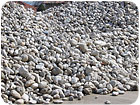
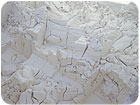
The look of lime is natural and soft. The light seems to go deeper into the plaster than with Portland cement mixes and acrylic finishes. Whereas common modern building materials seem to have a flat, synthetic look to them, lime finishes have an iridescence that make finishes look richer. When the light reflects from a lime building, it evokes emotions tied to tiny European towns, built house by house from artisans trained over generations in the family business.
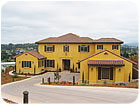
This home features seasoned-slaked lime plaster finishes for interior and exterior use. The project was completed by John Cravens Plastering, in Arroyo Grande, Calif.
The depth of color saturation and surface translucency is there immediately after completion of plastering. So, the building looks like a centuries-old Italian villa. On the interior, ceiling pot lights bring out the glow in the lime in the evening. But the exterior is where lime finishes really shine-the light plays off the aggregate (typically marble dust) and penetrates into the colored limestone and returns to the viewer with a warm and inviting look.
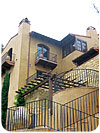
This home, in Laguna Beach, Calif., is an example of how contractors can use slaked lime near moisture-saturated areas.
What's in the Bucket?
Today's lime plaster is typically composed of lime, marble and quartz aggregate, and water. When it's made the old way, the lime is fired in a kiln at about 900 degrees C for a week to create quick lime. For the chemistry major, that is calcium oxide.iIn a quaint nod to European environmental sensitivity, the traditional Italian-lime kilns are fired with sawdust from nearby furniture manufacturers. Coal could not be used because of the sulfates it would introduce into the lime. The quick lime thus produced is evenly calcined and incredibly thirsty for water. So much so, in fact, that the simple act of adding water to it creates a violently exothermic (releases heat) reaction that creates a huge cloud of steam. Through this reaction, the baseball-size lime rocks are transformed into a liquid slurry calledLatte di Calce("lime milk"), made up of water and fine lime particles on the order of 1 micron. Grinding the lime is not necessary to achieve the fineness needed for fine plaster finishes.The product of the slaking process depends on the production process. In the traditional method of making "seasoned slaked lime," additional water is added in the slaking process to create a lime putty calledGrassello di Calce, technically calcium hydroxide plus free water. This putty is aged in a remarkable transformation in which the water content, workability, plasticity, crystal structure, and particle size develop into ideal plaster materials. After three months of slaking, lime is somewhat plastic and spreadable and provides good performance in mortars. After two years, it is striking how much more plastic the seasoned slaked lime has become and how much more body it imparts to the product.
During this time, the water content has increased significantly. Under the surface, even more is different after two years, as the particles have morphed from prism-shaped particles into flat plate-like crystals>iiin an orderly crystalline structure that reacts differently to light. It is this long slaking process that gives the best lime plasters their difference in workability and aesthetic impact. Ask manufacturers about how their lime is made and slaked, and for how long.
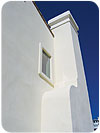
Antiqua I lime exterior finish used in Lake Sherwood, Calif. The application was completed by California Plastering.
Whatever lime is used, it needs to be mixed with clean, properly graded and shaped aggregate to produce a durable plaster finish. The European tradition is to use Carrara marble aggregate, which is chemically calcium carbonate or limestone. The geologic process has smiled on all marble though, because it is strong and creates beautiful effects with light. Artisans from generations ago used hair to give it strength and crack-resistance. And other creative additives-from oils to eggs-were used at one time to achieve the plasterer's vision. Today's Venetian plaster finishes borrow from the knowledge gained by generations of plasterers, and are designed to showcase the beauty of lime and marble, with the performance-enhancers to engineer around some of lime's inherent limitations.
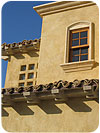
Antiqua I lime plaster finish applied near the water. This was completed by Il Colore and the location is Balboa, Calif.
The Modern Lime Plaster Finish
Whereas the traditional lime plaster system required months to cure out in three coats, today's applications provide all of the beauty and function of these traditional systems with much more practical working conditions. On the interior, lime finishes can go over Level 3 through 5 finishes of drywall-Level 3 if you're putting on an aggregated lime plaster, such asRialto Antiqua IorAntiqua II. You will need a Level 4 or 5 finish if applying a finer lime plaster to achieve a shiny marble effect, such asRialto Epoca Spatolato.Typically, a primer coat is needed to bridge the interface between gypsum wallboard and lime plaster. These are commonly acrylic or silicate primers with marble aggregate in them to provide for good adhesion to the substrate, a good key for the plaster finish coat, superior crack-resistance, and mold- and mildew-resistance. The finish coat is troweled on in two or three coats. This is necessary to achieve the full depth of color and mottling that only true lime products can produce.
In exterior applications, lime products can be matched up with modern materials to create an easy-to-apply, durable and attractive finish. In traditional stucco market areas, such as the Southwest, lime plaster is usually applied over lath, scratch and brown coats of Portland cement and sand, just as with normal stucco products. This system gives the fast completion time that builders demand from today's materials but still achieves the look of lime that takes yesterday's architecture to a higher level. The brown coat should be given additional care to ensure that no additional lime plaster material is used to fill in a rough brown, as these materials are expensive. As with interior applications, a primer coat is commonly employed to bridge the transition between Portland cement and lime. Then, two coats of lime plaster are troweled on. In other regions, lime plaster can be applied over properly prepared masonry or foam substrates, with a basecoat of cement plaster, cement board sheathing or other accepted cementitious substrate.

An interior application of Epoca Spatolato, located in Lemon Heights, Calif.
Features of Lime Plasters
Lime plasters have gained their niche in the U.S. market because of how they look. But they have important performance advantages, as well:- Crack resistance: Lime is far more flexible than Portland cement, so you can expect greatly reduced cracking with lime plaster.
- It is very breathable.
- Wets out and dries fast: This is a new way of thinking about water resistance. Whereas U.S. manufacturers typically try to keep water out, lime plasters perform very well in wet climates (such as in Europe) by simply allowing any water that is absorbed into the plaster to quickly evaporate and exit the structure. This makes lime plasters the only plasters that can tolerate rising damp and canal-side applications that would delaminate acrylics and Portland cement plasters.
- Self-healing: During construction, when buildings are most likely to be under stress, the fresh lime has been known to actually fill in small cracks that form due to stress. This may explain in part why lime plasters show far fewer cracks than Portland cement plasters. In fact, "ancient buildings have had lime mortar deep in walls which started to set when archaeologists exposed it."iii
- Naturally mold-resistant: Due to its high pH (between 11 and 12), lime is a natural biocide.
- Time tested: From early Egyptian, Greek and Roman efforts with lime, through the Golden Age of it in the 1800s, lime plasters have served as durable, beautiful finishes all over the world.
- Natural and green: Lime plasters are sustainable materials produced without plastics and harmful chemicals in keeping with traditional plastering methods.
- Easy to patch and maintain: Fresh lime plaster can be "brought back" with water spray between two to four hours after application. This gradual setting process allows for relatively easy repairs, compared to Portland cement and especially acrylic plasters.
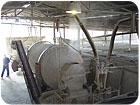
Stones are sent into a machine to be crushed, put into a furnace then placed into beds to be slaked from three to 24 months.
Additional Considerations When Using Lime
If you're like most American construction professionals, you have heard stories (maybe from your uncle or grandfather) of lime plasters that were slaked in holes in the ground on the job site and used after several months to plaster the interior. But there is a certain fear factor in bidding work using products that are new to someone, no matter how old and time-tested the product might be. Everyone new to using lime thus needs to keep the following things in mind when starting to take on lime projects:- Authentic materials cannot be made from "bag lime" and so must come from Europe, which means it will cost more. Labor expenses should be roughly the same as smooth Portland cement plaster finish but materials could run an extra $10 to 20 per square yard. Figure on the same applied cost as painted smooth stucco and you're probably in the ballpark. Manufacturers can also give guidance on how to bid the jobs.
- Pay special care to roof and deck runoff if you don't want that kind of character on your building; gutters are a good idea and designers need to realize that water running down a lime plaster will create an Old World look that not all homeowners appreciate.
- Extended cure time means extended vulnerability to freezing, so be sure that temperatures will not drop below freezing for about one week after application.
Lime plasters have arrived in the United States to support the demand for European architecture and high-end aesthetics. Their performance advantages are likely to keep them around for generations to come.
There are a lot of product offerings flooding the market these days, so be sure to ask the right questions about how the lime is produced. The real test is putting the materials on the wall, standing back and enjoying the warm, natural glow of the lime. With education and a little trial and error, lime plasters can elevate the appearance of a building and enable construction professionals to differentiate their work, recapture the tradition of artisans from generations before, and create art on the wall.
Sources & Endnotes
5400 S. 122nd E. Avenue, Tulsa, OK 74146 Tel: 800.879.8000 Fax: 918.252.6742 www.us.hilti.comi Note that Dolomitic lime is typically made up of calcium and magnesium oxides/hydroxides. This combination of calcium and magnesium is named after the Dolomites mountain range in Northern Italy, where some of the first and most ideal lime for building was discovered. The main lime deposit serving Southern California is also Dolomitic. It is the magnesium that improves the workability, hardness, and water resistance of the plaster.
ii Hansen, van Balen, and Rodriquez-Navarro, "Variations in High-Calcium Lime Putty and Mortar Properties Resulting from the Use of Freshly-Slaked Quicklime and Commercial Dry Hydrated Lime," from International Building Lime Symposium 2005
iii Schofield, Jane, Lime in Building, Black Dog Press, Devon, England, 1995, p. 10
If you read this article, please circle number 339.
